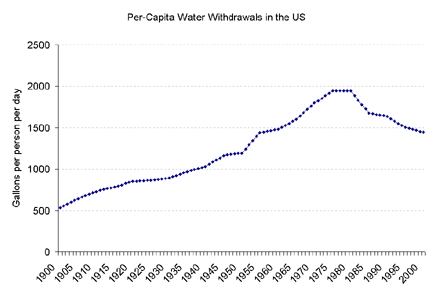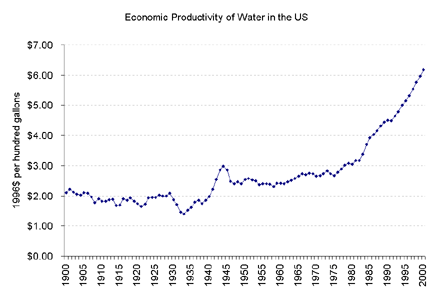|
U.S. Per Capita Water Use Falls to 1950s
Levels
Analysis of U.S.G.S Data Shows that Efficiency is Effective,
Demand is Not Endless
[Updated March 11, 2004] Oakland, Calif -- Total United States
water use barely changed in the five-year period ending in 2000
and is lower than it was in 1975. Per-capita water use has dropped
even more dramatically. At the same time, the economic productivity
of water in the US continues to improve. But, according to a Pacific
Institute analysis of United States Geological Survey (USGS) water
data released today, pumping of groundwater increased during this
period, which could pose a threat.
"According to new figures released today by the USGS, American
homes and businesses are becoming more efficient every year,"
said Dr. Peter Gleick, President of the Pacific Institute and
a 2003 MacArthur Fellow. "This shows that one of the key
assumptions of US water planners is wrong: we don't have to build
massive, new water projects to meet ever-increasing demand. This
allows us to avoid the economic, social, and environmental costs
of building new dams, while ensuring we have the water we need
for human use, agriculture, and a healthy economy."
According to the new figures, released every five years by the
USGS, total water use increased by a paltry 1.7 percent from 1995
to 2000 (the most recent year for which numbers are available).
During that same period, per capita water use declined 4 percent.
The amount of water used per-person in the US is lower now than
it has been since the mid-1950s. And per-capita water use in the
nation has dropped more than 25 percent from its peak in the late
1970s.
"As these new data show, our modest efficiency and conservation
efforts, combined with other technological and economic changes,
have allowed us to cut per capita use even as our economy grows,"
Dr. Gleick noted. "But the bad new is that pumping of groundwater
has increased. And in too many places our underground aquifers
are already over stressed. Although groundwater is an important
source of water, it's not unlimited and it's not being used responsibly."
The United States, although relatively water-rich, faces a range
of threats to its vital supplies of fresh water. Overuse has turned
the mighty Colorado River into little more than a trickle. Overuse
and contamination threaten the massive Ogallala aquifer, which
runs from Texas to South Dakota and is an important source of
irrigation and drinking water. And other serious threats to our
water resources -- like climate change, wetland destruction, and
population growth -- loom large.
"The new USGS figures demonstrate that even our limited
efforts to cut wasted water have yielded big results," continued
Gleick, "But we are being hamstrung by our lack of a coherent
national water policy. If we plan intelligently and improve our
efficiency efforts we can have clean, secure supplies of freshwater,
a thriving economy, and a healthy environment."
Selected Data Facts from the Pacific Institute analysis of new
USGS data:
- Total water use in the US in 2000 is lower than it was in
1975.
- Per-capita water use in the US in 2000 is lower than it has
been since the mid-1950s.
- The economic productivity of water (dollars of Gross National
Product per unit of water used) is higher than it has ever been:
it has more than doubled since the 1970s, to $6.20 per hundred
gallons used.


Download
these graphs with data as an Excel file.
Useful Links
USGS data page: http://water.usgs.gov/pubs/circ/2004/circ1268/
"Waste Not, Want Not" looks at California's urban efficiency:
http://www.pacinst.org/reports/urban_usage/
Pacific Institute proposal to create a National Water Commission:
http://www.pacinst.org/publications/testimony/
national_water_commission.htm
Science Magazine piece looks at sustainable solutions for the
global water crisis: http://www.pacinst.org/reports/science_12_03/
###
Download this release as a PDF
|